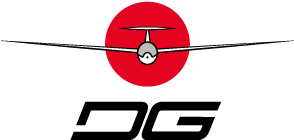LS8: The first Turbos from Bruchsal
Article from Aerokurier 09/2005 by Gerhard Marzinik
After taking over the LS line of gliders, DG recently delivered the first LS8-st gliders. What has changed and what remains the same with this successful design?
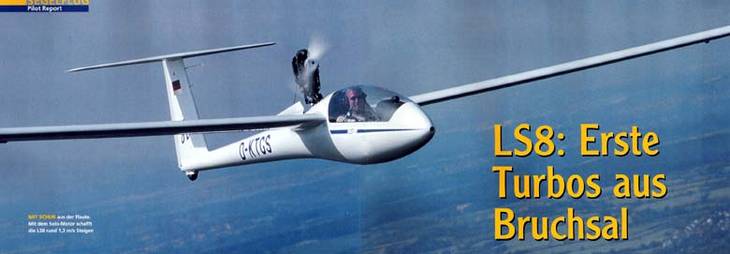
The LS8 first flew ten years ago (pilot report the championmaker, Aerokurier 11/1994) und is still as relevant today as it was then. Competition pilots swear by it. Clubs and leisure pilots love it. Gerd-Peter Lauer just won the standard class German Nationals flying an LS8 (he tied for first with Reinhard Schramme competing with a Discus 2a) and Czech Pavel Pouzecky won the European Championships. In the 18m-class dominated by flapped ships, Swiss Rolf Friedli managed to finish fourth in his LS8-st, behind three pure 18m gliders.
After its debut as a standard class glider with a 15m two-panel wing, the LS8 was soon fitted with modified wing extension panels from the LS6 to become an entrant into the 18m class. Just how competitive the LS8 with the extended wingspan really is, was demonstrated by Claus Triebel when he finished first during the 18-m German Nationals in Mengen in 2000.
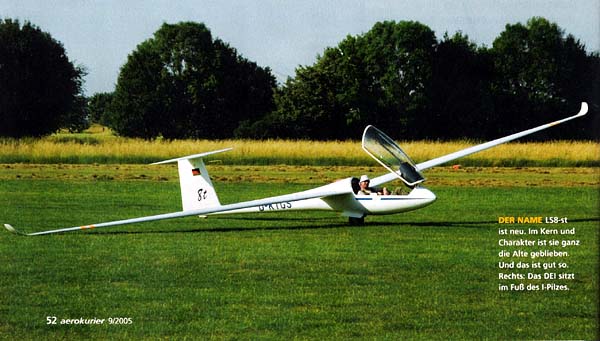
The last models to leave the Rolladen-Schneider factory in Egelsbach prior to its insolvency were the LS8-b and -t. After the transfer of production to the DG facility in Bruchsal, these models became the LS8-s and st. So, what does the s stand for?
It could be s as in sound and solid or, more aptly, conventional technology. This is because with the change from the -t to the -st, DG replaced the somewhat exotic hydraulic extension and retraction mechanism for the sustainer engine with a more conventional electric motor driven worm gear drive. Just like the -b model from Egelsbach, the -s features a large 5-inch wheel and will be certified for a MTOW of 575kg (1,269 pounds) with the 18-m wing. That makes it a very suitable glider for strong conditions with excellent lift or streeting. The resulting maximum allowable wing load of more than 10 lbs/sqft keeps it competitive in the face of changing competition rules that allow higher wing loads.
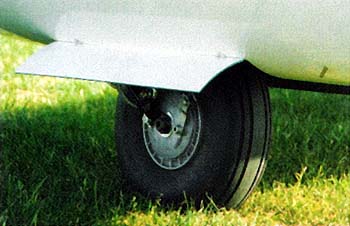 To find out whether the LS8-st retains its LS character, we decided to test fly it. After all, with the changes to the sustainer engine system, elements that are distinctly DG are now part of the glider. Our test glider was an LS8-t originally built in Egelsbach but modified to feature the new DG sustainer engine extension and retraction system.
To find out whether the LS8-st retains its LS character, we decided to test fly it. After all, with the changes to the sustainer engine system, elements that are distinctly DG are now part of the glider. Our test glider was an LS8-t originally built in Egelsbach but modified to feature the new DG sustainer engine extension and retraction system.
At first sight, there is no difference to the LS8-t I flew three years ago when visiting with Rolladen-Schneider (pilot report, Aerokurier 8/2002). The engine controls have been changed, however, and the original ILEC engine control unit has been replaced by the DG DEI (Digital Engine Indicator) system a subtle reminder of the changes to the sustainer engine extension and retraction system. No changes have been made to the seatback which is still not adjustable in flight, and the glider still features the LS-typical drum brake that is actuated through applying heel pressure to the rudder pedals. The 18-m wings are adorned by sleek LS-winglets. The 15-m winglets continue to be what pilots have nicknamed elephant ears. Everything that was initially suspected to be wanting has turned out to be practical and performance enhancing upon closer inspection.
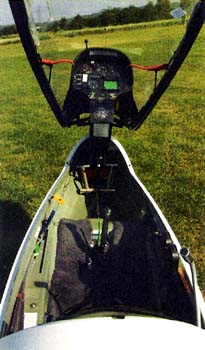 Behind Alwin Günterts 360hp-hot rod SP91 is airborne almost as soon as there is tension on the towrope. That is not surprising as the overall weight gain is very modest. The strengthened main spar and the additional structural strengthening necessitated by the engine in the fuselage were compensated for by using carbon fiber instead of glasfiber for the vertical stabilizer. The fuel reservoir and engine add another 30kg (66lbs).
Behind Alwin Günterts 360hp-hot rod SP91 is airborne almost as soon as there is tension on the towrope. That is not surprising as the overall weight gain is very modest. The strengthened main spar and the additional structural strengthening necessitated by the engine in the fuselage were compensated for by using carbon fiber instead of glasfiber for the vertical stabilizer. The fuel reservoir and engine add another 30kg (66lbs).
Once airborne, the additional weight in the fuselage is imperceptible. I make a few tight turns in the first weak bubbles of blue lift on a summer morning. A few turns to get a feel for todays lift and I am completely at home in the LS8. Almost as an afterthought, I realize how quickly my attention has shifted to the ups and downs of the wingtips, which have become almost like an extension of my own body. Detecting thermals is easy in the LS8.
The controls are very balanced. If anything could be improved I would ask for a slightly more effective rudder. First signs of lift effortlessly lead to centering the sweet spot of todays thermals. Once centered, the glider turns in a pleasantly stable manner. That does not mean that the LS8 isnt nimble: It can indeed be very agile if required and 45-to-45 degree roll rate comes in at 4 and a half seconds at 95km/h (51 kts).
The stall is preceded by a very noticeable high nose attitude accompanied by strong buffeting. Even as the instrument panel shakes, all controls retain their effectiveness. The predictable behavior at stall speed without any vicious surprises conveys a strong sense of safety. The shaky instrument panel raises questions about passive safety in the event of a crash but with its structural reinforcements the LS8 should meet fairly demanding standards of passive safety, as was already argued by Rolladen-Schneider.
The engine starts up quickly. The DEI makes operation simple and reduces the necessary attention to a minimum by automating most steps. The checklist for this maneuver is fairly short: Reduce speed to 90 km/h (49 kts) to make it easier for the extension mechanism to do its work, open the fuel valve, turn on the ignition (this activates the extension mechanism for the engine), and, as soon as the engine is in its upright and locked position, press the decompression valve and accelerate to 140 km/h (76 kts).
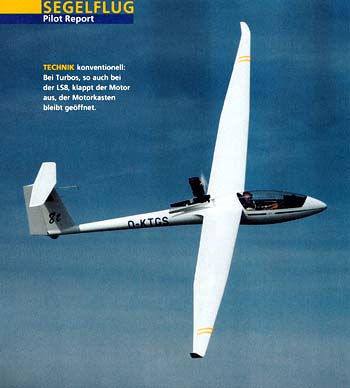 The windmill effect easily rotates the propeller. As soon as the decompression valves are closed, the engine fires up and speed can be reduced to 90 km/h (49kts) for the best rate-of-climb. The whole maneuver results in an altitude loss of about 100m (328 ft). After pulling out of the dive a net loss of about 40m (131 feet) remains. I try it out a few times. The engine starts up reliably every time. Even in a stressful situation the high degree of automation should enable to pilot to successfully perform this operation.
The windmill effect easily rotates the propeller. As soon as the decompression valves are closed, the engine fires up and speed can be reduced to 90 km/h (49kts) for the best rate-of-climb. The whole maneuver results in an altitude loss of about 100m (328 ft). After pulling out of the dive a net loss of about 40m (131 feet) remains. I try it out a few times. The engine starts up reliably every time. Even in a stressful situation the high degree of automation should enable to pilot to successfully perform this operation.
According to the flight manual, the LS8 climbs at 1.3m/s (256 fpm or 2.5 kts) at 500m MSL (1,640 feet). At 2,000 m (6,562 ft) it is rated at 0.7 m/s (138 fpm or 1.4 kts). In todays turbulent air, these claims are difficult to verify. I am climbing, sometimes more, sometimes less. Accelerating to 140 km/h (76 kts) results in level flight, which may be useful to escape class C airspace limitations horizontally as an example. Best range is accomplished by flying in saw tooth mode, alternating between climbing at best rate-of-climb speed and gliding at best L/D. Refueling of the 17-liter (4.4 gal) tank is accomplished via an internal fuel pump and a quick-snap hook-up adapter.
When retracting the engine the DEI really shines. Once the ignition is turned off, the engine folds back a bit, winds down (which can be accelerated by opening the decompression valves below 1,000 rpm). The position shift of the engine prior to its winding down appears counterintuitive as the rotation is facilitated the most easily in the upright position, but the system works. Once the propeller has come to a full stop or rather sufficiently close to a full stop, the engine moves back a little further yet to allow the propeller stopper to enter the propeller disc. As soon as the propeller is in its vertical position next to the stopper, the engine is fully retracted. The process of retracting the engine can be accelerated through increased airspeed and by using the decompression valves.
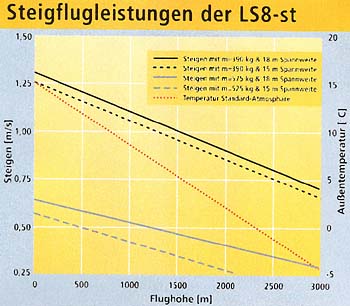 The DEI system keeps the pilot informed about the status of the engine system throughout the entire process. A graphic display indicates the engine position. In addition there is a little mirror for visual inspection. The location of the DEI is less than optimal: Its location in the fixed base of the instrument panes saves space but it also means that the DEI is directly in front of the control stick, limiting access to it a bit.
The DEI system keeps the pilot informed about the status of the engine system throughout the entire process. A graphic display indicates the engine position. In addition there is a little mirror for visual inspection. The location of the DEI is less than optimal: Its location in the fixed base of the instrument panes saves space but it also means that the DEI is directly in front of the control stick, limiting access to it a bit.
When the engine is operating, DEI keeps the pilot informed about key metrics such as engine speed, temperature, and remaining fuel. There is also an engine failure indicator. For worst-case failures, the engine can be rotated backward in a manual mode to lower drag.
An extended engine that is not running roughly doubles minimum sink from 0.51 m/s (100 fpm or 1.0 kts) to 1.1 m/s (217 fpm or 2.1 kts). Best L/D is reduced from 48 at 100 km/h (54 kts) to 25 at 95 km/h (51 kts). There is hardly any attitude change in the case of an engine failure.
Overall, the change to the worm gear drive for the engine extension and retraction mechanism and the high level of automation in operating the engine afforded by the DEI represent a significant enhancement for Turbo LS8.
With everything else, the original character of the LS glider that has made it such a success remains unchanged.
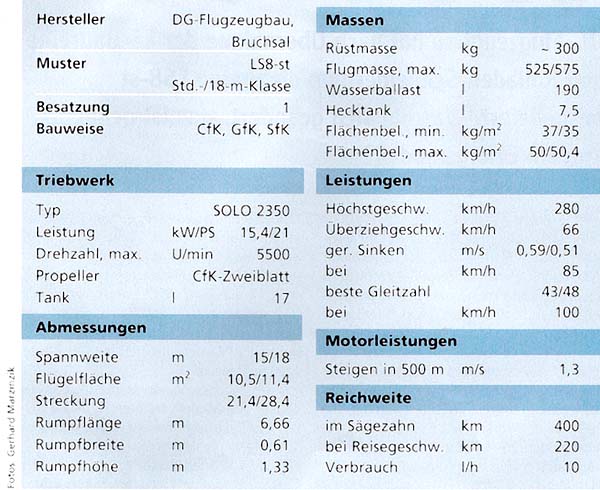
Gerhard Marzinzik
